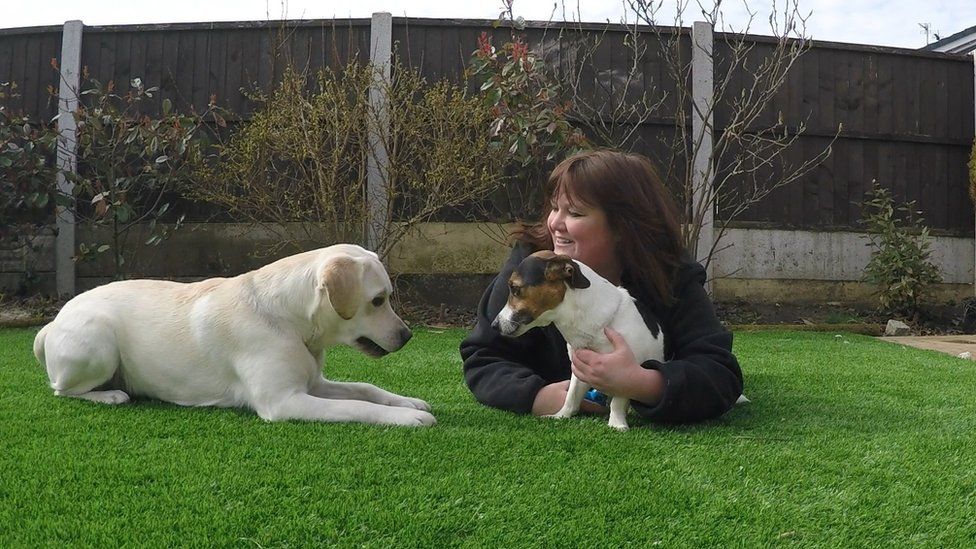When is it not OK to pet a stranger's dog?
- Published

Carol Willacy says even working dogs like Charlie, left, get "horrendous" attention from strangers
"I'm working" or "do not disturb" are messages usually worn by a guide or assistant dog.
The Royal National Institute of Blind People says petting a working dog risks "distracting the dog from its work" and "could put its owner at risk of danger".
But some pet owners are also saying they don't like strangers stroking their non-working dog.
Contact can also be a problem for owners of shy dogs, deaf dogs and puppies prone to bite or growl. Here's why some people are saying: "Please don't pet my dog."
1) 'My dog's deaf'
Debra Dorrans' black labrador-staffie Benny is 14 and has lost his hearing - so she worries "he might get a fright" if people come up to him and stroke him.
She also recently adopted seven-year-old Sam, a white westie who gets nervous around other dogs and children.
"I have heard of dogs biting children that have then had to be put down," she says.
"I've never been in that position, but I'm always aware."
Debra, a retired nurse, is one of 12,000 members of Facebook group Reactive Dogs, external, which brings together owners of dogs who show excessive fear or aggression around strangers.
"I always put my dogs first," says Debra.
"I don't want them to get into any trouble or bite someone."
She says she's not afraid to say no to people who want to pet her dogs, but warns that "you have to keep your wits about you".
"One day a small child ran up to Benny and wrapped his arms around him. I told the parents they shouldn't do that, but they didn't really seem to understand."
2) 'Quite alarming'
"I'm not embarrassed to say to someone - please don't pet my dog," says Dale McLelland, from Ayrshire, owner of two-year-old Hattie.
She says people "absolutely make a beeline" for the old English sheepdog.
"It's hairy dog syndrome. She looks so cute."
But she explains it can be "quite alarming for her" if too many people approach Hattie during her walks.
Dale, who has worked as a dog behaviourist for 10 years, says dogs can find strangers' hugging and petting intrusive.
"Can you imagine if you were on a train and every second person came over and touched you, how uncomfortable that would make you feel?"
Dog person? The correct way to pet a stranger's pooch
Never leave your child alone with a stranger's dog
And don't approach a dog without an owner around
Only stroke the a dog if the owner says, "Yes, you can"
Get the dog to sniff your hand first, then stroke gently
If a strange dog approaches you - stand still, look away and cross your arms
Source: Dogs Trust
Dale avoids busy places, and volunteers for Yellow Dog, a US-based project, external that advocates putting a yellow ribbon on a dog to show that they need space.
"The problem is, not many people know what the ribbon means - and those that do are normally clued up."
She adds: "I had rottweilers for 20 years - and only people who probably knew the breed came over and touched them."
3) 'My dog IS working'
But even working dogs get disturbed, according to those who rely on them.
Carol Willacy says her assistance dog Charlie, a golden labrador, is "my life, everything" - but that the attention he gets from strangers can be "horrendous".
She says about 50 people will approach her on a trip to the supermarket, even if he is wearing his harness.
"The 'do not distract' message doesn't make a difference," she says.
"There's a saying at least half of people come out with, 'I know I'm not supposed to touch your dog, but...'"
Carol, 48, suffered a spinal injury as a teenager and also has functional neurological disorder (FND), meaning she uses a wheelchair and had to give up her job as a pharmaceuticals account manager.
Three-year-old Charlie helps Carol by passing her things and, crucially, detects and warns her if she is unwell.
"If your dog is going to tell you you're not feeling well, you want that dog to be focused and not stroked and stopped," she says.
"My previous assistance dog was a little Jack Russell and we had the same problem. He had to retire as he got grumpy with people," she says.
4) 'I'm training my puppy'
Dog trainer Luke Balsam, who runs a school in London, says puppies in particular should be left alone - as they are still getting used to walks and being around strangers.
"People are drawn to puppies," says Luke, who owns a cocker spaniel, Indie.
"But some don't think it's necessary to ask the owner's permission."
In London, where lots of people live in flats and might not own a pet, seeing dogs on the Tube or in cafes can be a novelty.
Luke says public-shy owners should go "off the beaten track", like a wooded area, until they have trained a puppy or dog to walk around in busy places.
But he says anyone worried their dog might bite or nip a person should use a muzzle.
"It's definitely recommended," he says.
"The muzzle should be an essential part of training your dog, and they can be taught to enjoy wearing it."
- Published20 November 2017
- Published31 August 2017
- Published27 October 2017
- Published27 September 2017
- Published19 April 2017